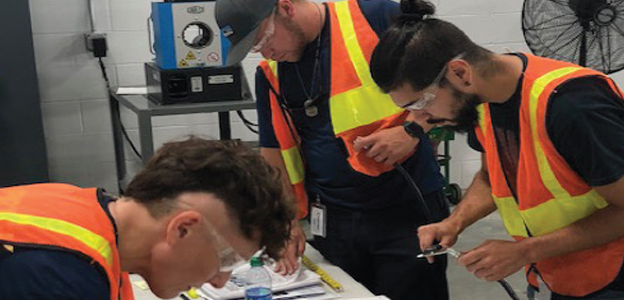Originally published in Hose + Coupling World – August 2022
As Summer kicks into full gear, companies – especially those in essential industries like construction, agriculture, and manufacturing – are busier than ever. When it comes to meeting deadlines, individuals rely on systems to operate smoothly. When a machine is not working properly, it can pose a major threat to both a company’s bottom line and its reputation.
Maintenance – especially for hydraulic hoses – needs to be a year-round endeavor. It requires special attention during the hot and busy Summer months. Hydraulic hoses are vital components to many different types of machines, and if they are not working properly, there can be serious risks involved. From safety hazards to expensive equipment damage and environmental repercussions, there are plenty of reasons to inspect hydraulic hoses regularly and replace them when in doubt.
By Mike Rutan, Product Development Manager, PIRTEK USA
While businesses everywhere were being shut down during the pandemic, essential industries needed to remain strong and operate under extraordinary circumstances. The last thing any industry would want is for projects to shut down simply because the required maintenance was neglected on the machinery.
The Importance of Maintenance
What are the consequences of falling behind on hydraulic hose maintenance? Here are a few reasons why this issue deserves a company’s time and resources:
Hydraulic hoses have a limited lifespan. There are many variables that determine the lifespan of a hydraulic hose. Most hoses are rated on the number of impulse cycles that they can withstand; many modern hoses are rated as high as one million impulse cycles. However, if they are not maintained properly, there are several big risks involved, and they will require replacement more often.
Age is a key factor, especially when considering the purpose of hydraulic hoses. From high temperatures and strong chemicals to extreme amounts of pressure, they are made to withstand extreme conditions. Like anything else, they will weaken from various breaks and abrasions over time. Hoses that are not properly fitted can also experience unnecessary leaks and breakages.
Faulty hoses are a safety hazard. There are so many things that could go wrong when a hydraulic hose is not working properly. For instance, if a leak occurs, hot substances and dangerous chemicals can pose major health risks. Hydraulic hoses that leak oil can also cause slips and falls, and some of the chemicals transferred in the hoses are extremely flammable, creating an even greater risk to anyone near them.
Compromised hoses can cause costly damage. When a hydraulic hose stops working, it can damage other machine parts. This could amount to a heavy financial burden, as the repair and replacement costs can be quite substantial. There is also a risk that the business will have to temporarily shut down until the machines are back in order.
Falling behind on hose maintenance is dangerous for the environment. Faulty hoses can be the cause of environmental disasters like oil spills. These kinds of occurrences damage entire ecosystems and put wildlife and even human lives at risk. Plus, you can get yourself into a major publicity crisis and huge cleanup costs.
Luckily, there are steps that can be taken to maximize the lifespan of your hoses, avoid any safety issues, and ensure that they are replaced at the appropriate times.
1. Have a Dating System in Place
Whether it is a written or digital system, record-keeping is an essential part of any business. To help maintain hoses for their full lifespan, be sure to keep track of their manufacturing dates. These can usually be found on the outer cover.
Operators will also want to write down when each new hose is put into service or tag them accordingly. This can help to estimate when a hose is near the end of its lifespan. It is important to update the list regularly as hoses are replaced.
2. Take Precautionary Measures
When a hose is installed, the most important thing to do is make sure it is protected. Spring guards are meant to help protect the hose from debris. It is also advised that any hoses near a machine operator are covered with a burst sleeve.
If a hose is directly exposed to UV light- especially in sweltering Summer temperatures- a nylon sleeve should be considered. Plastic wrap protects hoses from the wear and tear caused by friction with other components, while whip checks help protect anyone working near the hose ends.
Make sure the hoses are secured in place to ensure they function properly and to help prevent damage. If the operator sees or feels any gaps or hears any noises that lead them to believe they are not fitted properly, they should turn off their machinery and schedule a professional inspection immediately.
3. Conduct Physical Inspections
Speaking of inspection, to help prevent spills and other dangerous occurrences, inspect hoses often. Anything that looks ‘off’ should typically be investigated, especially if any obvious leaks, cracks, brittleness, oil permeation, or color changes are noticed. Even the smallest physical changes can be a sign of a serious problem.
Look out for things that can happen over time, like twisting or binding. Minor binds can still decrease a hose’s lifespan significantly.
Finally, make sure all parts are accounted for and replace any that are missing or damaged immediately. These can include anything from clamps to guards, tie wraps, sheaves, or pullies.
4. Put Your Hoses to the Test
Of course, the easiest way to spot faulty components is to test the machines. Operate them as one would normally, and look out for leaks, rubbing, twisting, and stretching of the hydraulic hoses.
Hydraulic oil should also be checked regularly to make sure it is not discolored, milky, or foamy. These are all signs of contamination and can cause premature hose failures. In addition to the oil, consult a professional lab to analyze hydraulic fluid regularly, as it plays a crucial role in the hose’s operation.
5. Take Action Right Away
This summer may be busier than ever, but operators should not wait to replace damaged or outdated hoses. Because of the safety risks faulty hoses can produce, they must be replaced as soon as they show any signs of malfunction.
Final Thoughts
The bottom line is: most system failures and workplace accidents can be prevented. Maintenance is key, especially when working with complex systems, chemicals, and high-temperature fluids. From saving on replacement costs and business shutdowns, to keeping anyone working near the machines safe, engaging in regular hose maintenance is invaluable.
Lastly, do not use the busy Summer working season and high temperatures as an excuse to ignore hydraulic hose maintenance. This is the time when their upkeep should be a top priority.

Mike Rutan has over a decade of experience working at PIRTEK. Prior to his current role as Product Development Manager, he served as Operations Support Specialist and Operations Management, where he was in charge of Supervision of Mobile Sales and Service Technicians (MSST’s), Purchasing, Inventory Management, Customer Relations, Sales, Hydraulic Hose Assembly, and Preventative Maintenance. Mike has his IHSA High Risk Maintenance Level Hydraulic Safety Awareness Certification and IFPS Connector and Conductor Certification, as well as a Mechanical Engineering Technology degree from Purdue University.



